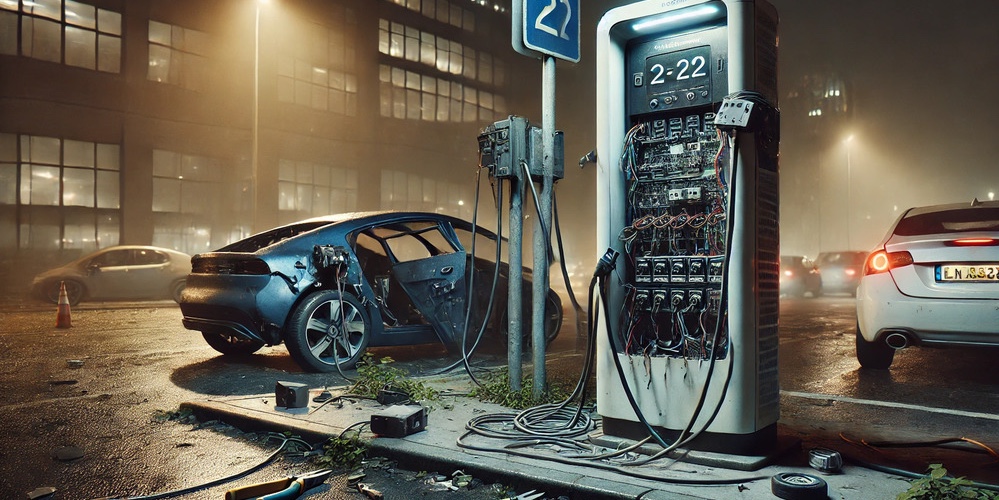Acts of vandalism at public charging points have become a priority challenge for CPOs, installers and manufacturers.
These incidents not only cause significant economic and physical damage that affects the availability of the infrastructure, but also represent a challenge to maintaining user confidence.
In this context, what do industry experts advise?

One of the strategies is the installation of video surveillance cameras at the location, a measure supported by Elis Álvarez González, CEO of Smart Wallboxes.
“The only way to stop vandalism is through video surveillance measures,” he told Mobility Portal España.
However, some experts point out that the implementation of cameras faces legal limitations related to data protection.
In this sense, Álvarez González criticizes this normative contradiction:
“Traffic radars are constantly recording to prevent vandalism, it would make no sense if the same logic were not applied to charging stations.”

For his part, Antonio José Pérez Sánchez, CEO of Mi Cargador de Coche, suggests other alternatives such as the incorporation of retractable hoses, similar to those at gas stations, to prevent thieves from cutting the cables.
At the same time, it recognises that this type of solution involves additional costs that could be reflected in the final price of the services.
In this context, he points out that tougher penalties for thieves would also be effective.
“It is very complicated to implement physical measures such as placing a guard next to each charger; it is more realistic to look for technological or legislative solutions,” he explains.
Inductive charging systems that do away with cables altogether could also be a solution, but this technology is still in the development and research phase.
Who should ensure safety at chargers?
For the CEO of Smart Wallboxes, responsibility should fall on the owners of the charging points, whether they are in the public or private sector.
“If you install a charger, you have to take care of the safety of the equipment to avoid problems,” he explains.
Regarding the prevention of hose theft, Juan Manuel Moya García, from the Association of Electric Vehicle Users (AUVE), proposes the traceability of copper through an identification system such as a DNA or DNI of the material.
This would allow their origin to be traced and discourage their theft.
As well as reducing the resale market.
It is important to note that this year, regions such as Tarragona, Reus and Baix Penedès have reported constant thefts of copper cables.
This has left “refuelling” points out of service for weeks or even months, generating significant costs for operators.
Repairing a device can cost more than 1,000 euros and, in some cases, up to 8,000 euros.
The value that a thief can obtain is low, around 15 or 20 euros.
The main factor that facilitates this act of vandalism is that the cables do not have electrical tension until the vehicle is connected, which makes them easy to cut and fragment.
Increase in cyber attacks in the sector
The security problem is not limited to physical vandalism.
Cyberattacks also pose a growing risk to charging infrastructure.
A technology specialist warns: “Without adequate cybersecurity measures, charging points can be vulnerable to data theft or even operational disruption.”
The implementation of advanced firewalls and encryption systems becomes a priority to protect both users and operators.
Technologies such as the Plug&Charge system, which allows automatic user authentication without the need for apps or cards, are gaining popularity in this field.
A specialist consulted by Mobility Portal España, indicates: “This system, although efficient, needs reliable connectivity and robust data protection measures to be truly effective.”
This implies the need for a robust network, such as 4G or even 5G, and advanced firewalls that use artificial intelligence to prevent known attacks on communication systems such as OCPP.
Tesla as a reference in safety
Elon Musk‘s company has proven to be a benchmark in protecting its infrastructure.
“Superchargers are equipped with video surveillance and are located in strategic locations, such as private premises or guarded areas,” says Elis Álvarez González.
This model not only reduces vandalism, but also improves the user experience by ensuring that the chargers are always operational.
“There is no need to worry about a device being out of service,” he emphasizes.
However, replicating this model on a general level poses economic and logistical challenges.
Not all operators can invest in advanced security systems or secure the location of their chargers in protected areas.
This leaves many vulnerable spots, especially those in remote areas where charging demand is growing.








